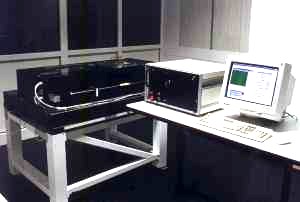Tutorial
Three basic elements constitute diffractometers (also called
scatterometers): thermostatic cell, light source, photodetector. The
thermostatic cell contains the sample to be analysed, typically in a
liquid or gaseous status, and allows to regulate the sample temperature
according to a programmed law, under computer control. A red or green
laser beam is commonly used as a light source, especially for dynamic
light scattering measurements, where narrow light bandwidth and high
coherence are mandatory. Due to the low scattering levels of many samples,
a photomultiplier or an integrating CCD-camera is often used as a
photodetector.
The above mentioned elements can be combined in a
variety of configurations, depending on the mechanical and optical
characteristics of the whole system. The most diffused configuration
consists of a thermostatic cell with a HeNe laser beam pointing at the
sample. In this case the photodetector is mounted on a moving arm, which
can rotate around the axis of the sample. The scattering angle is
determined as the angle between the laser and the photodetector. On most
sophisticated systems the rotation is performed under computer control. A
similar configuration consists of stationary photodetector, with a laser
mounted on the rotating arm. In this case, only small and low power lasers
can be employed. Both systems guarantee a good angular precision, but
their use can be particularly cumbersome - a stiff arm must rotate around
the cell. Moreover, changing the observation angle usually takes several
minutes, while measurements must be suspended. This limitation prevents
the simultaneous acquisition of scattering intensity from several angles,
which is of special interest in the study of the evolution of fast kinetic
phenomena (sol-gel transitions, etc.). In a different approach, the
simultaneous acquisition at different angles is obtained using many
photodetectors. For space reasons, fibers can be employed to convey the
light from the sample, at the right observation angle, to the
photodetector. The main drawbacks of this configuration are:
- the system is very expensive, as 10 to 20 photodetectors
(photomultipliers with power supply and signal conditioning
electronics) are usually involved;
- fiber optics are rather inefficient in transferring the scattered
light from the sample to the detector. Hence, the power of the laser
source must be greatly increased;
- the different photodetectors usually have different responsivities,
thus an accurate calibration should be performed before and during the
measurement session, as the operating conditions can change with time.
In the new DLS instrument from MICROTECH, the
thermostatic cell, the laser and the photodetector are all mounted on a
steady frame. Thanks to the original optical setup in the instrument,
there is no need for heavy moving components, and measurement from
different angles can be achieved almost simultaneously.

![]() static and dynamic light scattering
measurements
static and dynamic light scattering
measurements
![]() 5° to 150° angular range,
1°resolution
5° to 150° angular range,
1°resolution
![]() 5 ms angle settling time
5 ms angle settling time